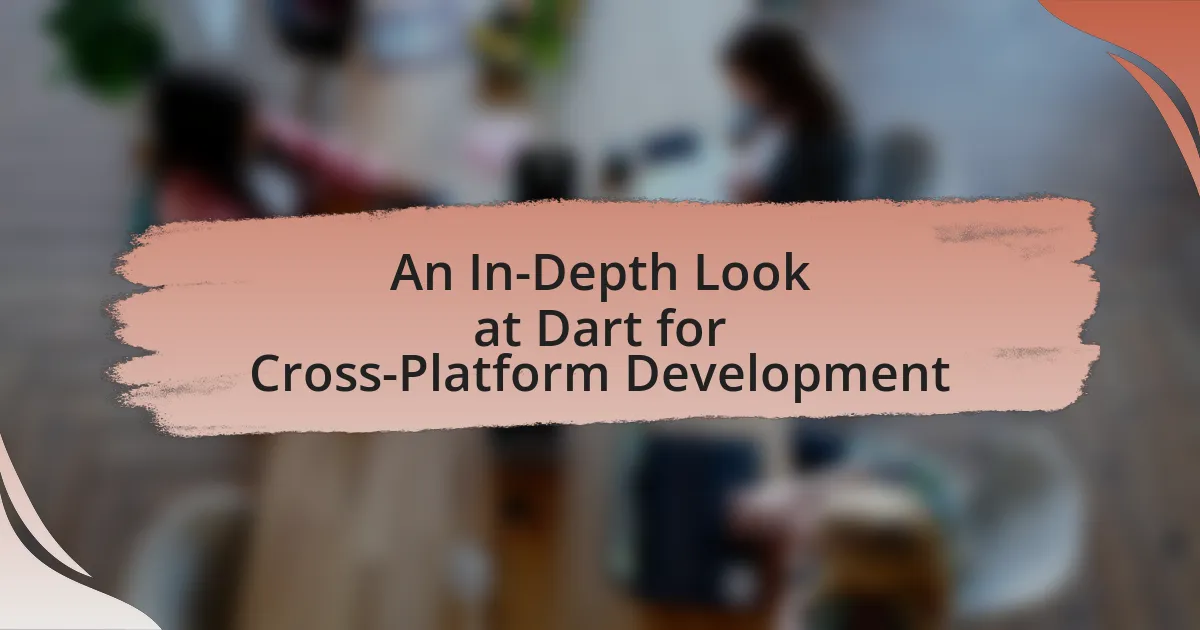Dart is a programming language developed by Google, essential for cross-platform development due to its ability to compile to native code for various platforms, including iOS and Android. The article explores how Dart facilitates cross-platform development through its single codebase, hot reload feature, and rich libraries, particularly in conjunction with the Flutter framework. It highlights Dart’s performance advantages, such as Just-In-Time (JIT) and Ahead-Of-Time (AOT) compilation, and compares its capabilities to other programming languages. Additionally, the article addresses best practices, common challenges, and available resources for developers to optimize their Dart applications and enhance their cross-platform development skills.

What is Dart and why is it important for cross-platform development?
Dart is a programming language developed by Google, designed for building web, server, and mobile applications. Its importance in cross-platform development stems from its ability to compile to native code for multiple platforms, enabling developers to write a single codebase that runs on both iOS and Android through frameworks like Flutter. This capability significantly reduces development time and costs while maintaining high performance and a consistent user experience across different devices. Dart’s strong typing, asynchronous programming features, and rich standard library further enhance its suitability for creating scalable and maintainable applications in a cross-platform environment.
How does Dart facilitate cross-platform development?
Dart facilitates cross-platform development by enabling developers to write code once and deploy it across multiple platforms, including web, mobile, and desktop. This is achieved through the Flutter framework, which uses Dart to create natively compiled applications. Dart’s Just-In-Time (JIT) compilation allows for fast development cycles, while its Ahead-Of-Time (AOT) compilation ensures high performance in production. Additionally, Dart’s rich set of libraries and tools supports seamless integration with various platforms, enhancing the development experience and efficiency.
What are the key features of Dart that support cross-platform capabilities?
Dart’s key features that support cross-platform capabilities include a single codebase, hot reload, and a rich set of libraries. The single codebase allows developers to write one version of the application that runs on multiple platforms, such as iOS, Android, and web, significantly reducing development time and effort. Hot reload enables developers to see changes in real-time without restarting the application, which enhances productivity and facilitates rapid iteration. Additionally, Dart provides a comprehensive set of libraries and frameworks, such as Flutter, which streamline the development process by offering pre-built components and tools tailored for cross-platform applications. These features collectively empower developers to create efficient, high-performance applications across various platforms.
How does Dart compare to other programming languages for cross-platform development?
Dart excels in cross-platform development compared to other programming languages due to its strong performance, ease of use, and robust ecosystem. Dart’s Just-In-Time (JIT) and Ahead-Of-Time (AOT) compilation enable fast development cycles and optimized performance for mobile and web applications. Additionally, Dart’s integration with the Flutter framework allows developers to create visually appealing and high-performance applications for both iOS and Android from a single codebase. According to the 2021 Stack Overflow Developer Survey, Dart’s popularity has been rising, particularly among mobile developers, indicating its effectiveness in cross-platform scenarios.
What are the advantages of using Dart for cross-platform applications?
Dart offers several advantages for cross-platform applications, primarily its single codebase for multiple platforms, which simplifies development and maintenance. This efficiency is enhanced by Dart’s Just-In-Time (JIT) compilation for fast development cycles and Ahead-Of-Time (AOT) compilation for optimized performance in production. Additionally, Dart’s rich set of libraries and frameworks, particularly Flutter, enables developers to create visually appealing and high-performance applications with ease. The language’s strong typing and modern features, such as async-await for asynchronous programming, further contribute to improved code quality and developer productivity.
How does Dart improve development speed and efficiency?
Dart improves development speed and efficiency through its Just-In-Time (JIT) compilation and Ahead-Of-Time (AOT) compilation features. JIT compilation allows for rapid development cycles by enabling hot reload, which lets developers see changes in real-time without restarting the application. AOT compilation enhances performance by compiling code to native machine code before execution, resulting in faster startup times and improved runtime efficiency. Additionally, Dart’s rich standard library and strong typing system facilitate easier debugging and code maintenance, further accelerating the development process.
What benefits does Dart provide in terms of performance and user experience?
Dart provides significant benefits in performance and user experience through its Just-In-Time (JIT) and Ahead-Of-Time (AOT) compilation capabilities. JIT compilation allows for faster development cycles by enabling hot reload, which lets developers see changes in real-time without restarting the application. AOT compilation, on the other hand, optimizes the application for production, resulting in faster startup times and improved runtime performance. Additionally, Dart’s strong typing and null safety features enhance code reliability and reduce runtime errors, contributing to a smoother user experience. These features collectively ensure that applications built with Dart are not only efficient but also provide a responsive and stable environment for users.
How does Dart’s architecture support cross-platform development?
Dart’s architecture supports cross-platform development through its single codebase approach, enabling developers to write code once and deploy it across multiple platforms, including web, mobile, and desktop. This is facilitated by the Dart VM, which allows for just-in-time (JIT) compilation during development for fast iteration, and ahead-of-time (AOT) compilation for optimized performance in production. Additionally, Dart’s rich set of libraries and frameworks, such as Flutter, provide a consistent UI and functionality across platforms, ensuring that applications maintain a native look and feel regardless of the operating system. This architecture not only streamlines the development process but also enhances code reusability and reduces maintenance efforts.
What are the core components of Dart’s architecture?
The core components of Dart’s architecture include the Dart VM, Dart SDK, and Dart libraries. The Dart VM is responsible for executing Dart code, providing features like just-in-time (JIT) and ahead-of-time (AOT) compilation, which enhance performance and startup time. The Dart SDK contains the tools and libraries necessary for developing Dart applications, including the Dart analyzer and package manager. Dart libraries offer a rich set of pre-built functionalities that developers can leverage to build applications efficiently. These components work together to create a robust environment for cross-platform development, enabling developers to write code that runs on multiple platforms seamlessly.
How does the Dart VM contribute to cross-platform functionality?
The Dart VM enhances cross-platform functionality by enabling Dart code to run natively on multiple operating systems without modification. This capability is achieved through Just-In-Time (JIT) compilation during development, which allows for fast iteration and debugging, and Ahead-Of-Time (AOT) compilation for optimized performance in production. The Dart VM’s architecture supports both mobile and web applications, allowing developers to write code once and deploy it across various platforms, including iOS, Android, and web browsers. This versatility is further supported by the Dart ecosystem, which includes libraries and frameworks like Flutter, facilitating seamless user experiences across devices.
What role do Dart libraries play in application development?
Dart libraries play a crucial role in application development by providing reusable code components that enhance functionality and streamline the development process. These libraries contain pre-written code for various tasks, such as handling HTTP requests, managing state, and implementing user interfaces, which allows developers to focus on building unique features rather than starting from scratch. For instance, the Dart standard library includes essential packages like ‘dart:core’ for fundamental data types and ‘dart:async’ for asynchronous programming, which are integral to efficient application performance. By utilizing these libraries, developers can significantly reduce development time and improve code quality, as they leverage tested and optimized solutions.
How does Dart integrate with popular frameworks for cross-platform development?
Dart integrates with popular frameworks for cross-platform development primarily through Flutter, which is a UI toolkit that allows developers to create natively compiled applications for mobile, web, and desktop from a single codebase. Flutter utilizes Dart as its programming language, enabling features like hot reload, which accelerates the development process by allowing developers to see changes in real-time without restarting the application. Additionally, Dart’s strong typing and asynchronous programming capabilities enhance performance and maintainability in cross-platform applications. The integration is further supported by Dart’s package ecosystem, which provides libraries and tools that facilitate the development of cross-platform features, ensuring a seamless experience across different platforms.
What is the relationship between Dart and Flutter?
Dart is the programming language used to build applications with Flutter, which is a UI toolkit for creating natively compiled applications for mobile, web, and desktop from a single codebase. Flutter relies on Dart’s features, such as its asynchronous programming capabilities and strong typing, to enhance performance and developer productivity. This relationship is foundational, as Flutter’s architecture is designed to leverage Dart’s capabilities for efficient rendering and smooth animations, making Dart an integral part of the Flutter development ecosystem.
How can Dart be used with other frameworks like AngularDart?
Dart can be used with frameworks like AngularDart by leveraging its strong support for reactive programming and component-based architecture. AngularDart is specifically designed to work seamlessly with Dart, allowing developers to build web applications using Dart’s features such as strong typing, async programming, and a rich standard library. This integration enables the creation of highly interactive and maintainable applications, as AngularDart provides tools for dependency injection, routing, and templating, all while benefiting from Dart’s performance optimizations. The compatibility between Dart and AngularDart is further evidenced by the official documentation and community resources that facilitate the development process, ensuring that developers can effectively utilize Dart’s capabilities within the AngularDart framework.

What are the best practices for using Dart in cross-platform development?
The best practices for using Dart in cross-platform development include leveraging Flutter for UI consistency, utilizing Dart’s asynchronous programming features for efficient performance, and adhering to the Dart language’s strong typing system for better code quality. Flutter, which is built on Dart, allows developers to create visually appealing and responsive applications across multiple platforms with a single codebase, enhancing development efficiency. Dart’s support for asynchronous programming through Future and Stream classes enables developers to handle tasks like network requests without blocking the main thread, improving user experience. Additionally, using Dart’s strong typing helps catch errors at compile time, leading to more robust and maintainable code. These practices are supported by the growing adoption of Dart and Flutter in the industry, evidenced by a significant increase in Flutter’s popularity among developers, as reported in the Stack Overflow Developer Survey 2023, where Flutter ranked as one of the most loved frameworks.
How can developers optimize their Dart code for performance?
Developers can optimize their Dart code for performance by utilizing effective coding practices such as minimizing object creation, using const constructors, and leveraging asynchronous programming. Minimizing object creation reduces memory overhead and garbage collection frequency, which enhances performance. Using const constructors allows Dart to reuse instances, further improving efficiency. Additionally, leveraging asynchronous programming with Future and Stream classes helps in managing I/O operations without blocking the main thread, leading to smoother user experiences. These practices are supported by Dart’s performance benchmarks, which indicate that optimized code can significantly reduce execution time and resource consumption.
What coding standards should be followed when using Dart?
When using Dart, developers should adhere to the Dart Style Guide, which emphasizes readability and consistency in code. Key standards include using camelCase for variable and method names, following a 2-space indentation for code blocks, and placing a space after commas in lists. Additionally, developers should utilize the Dart analyzer to enforce these standards and ensure code quality. The Dart community actively maintains these guidelines, which are documented in the official Dart documentation, reinforcing their importance for collaborative and maintainable code.
How can developers effectively manage dependencies in Dart projects?
Developers can effectively manage dependencies in Dart projects by utilizing the package manager, Pub, which allows for easy addition, updating, and removal of packages. By defining dependencies in the pubspec.yaml file, developers can specify the required packages along with their versions, ensuring compatibility and stability. Furthermore, running the command “pub get” retrieves the specified packages and their dependencies, while “pub upgrade” updates them to the latest compatible versions. This structured approach to dependency management helps maintain project integrity and reduces conflicts, as evidenced by the Dart community’s reliance on Pub for managing over 20,000 packages available on the Dart package repository, pub.dev.
What common challenges do developers face when using Dart for cross-platform development?
Developers face several common challenges when using Dart for cross-platform development, including limited library support, performance issues, and a smaller community compared to more established languages. Limited library support can hinder developers as they may not find necessary packages or tools, which can slow down the development process. Performance issues may arise due to Dart’s Just-In-Time (JIT) compilation, which can affect startup times and overall app responsiveness. Additionally, the smaller community means fewer resources, tutorials, and forums for troubleshooting, making it harder for developers to find solutions to problems they encounter.
How can developers troubleshoot issues related to Dart’s performance?
Developers can troubleshoot issues related to Dart’s performance by utilizing the Dart DevTools suite, which provides a comprehensive set of performance analysis tools. These tools allow developers to monitor CPU and memory usage, identify performance bottlenecks, and analyze the rendering performance of their applications. For instance, the Flutter performance overlay can highlight frame rendering times, enabling developers to pinpoint areas that require optimization. Additionally, using the Dart Observatory can help in tracking down memory leaks and understanding the allocation of resources during runtime. These methods are validated by the effectiveness of the Dart DevTools in real-world applications, as they have been widely adopted by the Dart community for performance optimization.
What are the common pitfalls to avoid when developing with Dart?
Common pitfalls to avoid when developing with Dart include neglecting proper error handling, which can lead to unhandled exceptions and application crashes. Developers often overlook the importance of asynchronous programming, resulting in performance issues and unresponsive applications. Additionally, failing to manage dependencies effectively can cause version conflicts and increase the complexity of the project. Not utilizing Dart’s strong typing system can lead to runtime errors that could have been caught at compile time. Lastly, inadequate testing practices can result in undetected bugs, compromising application quality. These pitfalls can significantly hinder the development process and affect the overall performance of Dart applications.
What resources are available for learning Dart and improving cross-platform development skills?
The primary resources available for learning Dart and enhancing cross-platform development skills include the official Dart documentation, online courses, and community forums. The official Dart documentation provides comprehensive guides, tutorials, and API references, making it an essential starting point for learners. Online platforms like Udemy, Coursera, and Pluralsight offer structured courses that cover Dart programming and Flutter for cross-platform development, often featuring hands-on projects. Additionally, community forums such as Stack Overflow and the Dart community on Reddit facilitate peer support and knowledge sharing, allowing developers to ask questions and share experiences. These resources collectively support effective learning and skill improvement in Dart and cross-platform development.
Where can developers find official documentation and tutorials for Dart?
Developers can find official documentation and tutorials for Dart on the Dart website at dart.dev. This site provides comprehensive resources, including language specifications, API references, and step-by-step tutorials designed to help developers learn Dart effectively. The documentation is regularly updated and maintained by the Dart team, ensuring that it reflects the latest features and best practices in Dart programming.
What community resources and forums are helpful for Dart developers?
Dart developers can benefit from several community resources and forums, including the Dart community on Reddit, Stack Overflow, and the official Dart Discord server. The Dart community on Reddit provides a platform for discussions, sharing projects, and seeking advice, while Stack Overflow offers a vast repository of questions and answers specifically related to Dart programming. The official Dart Discord server facilitates real-time communication among developers, allowing for immediate support and collaboration. These platforms collectively enhance the learning experience and foster collaboration within the Dart development community.

Leave a Reply